Belgium
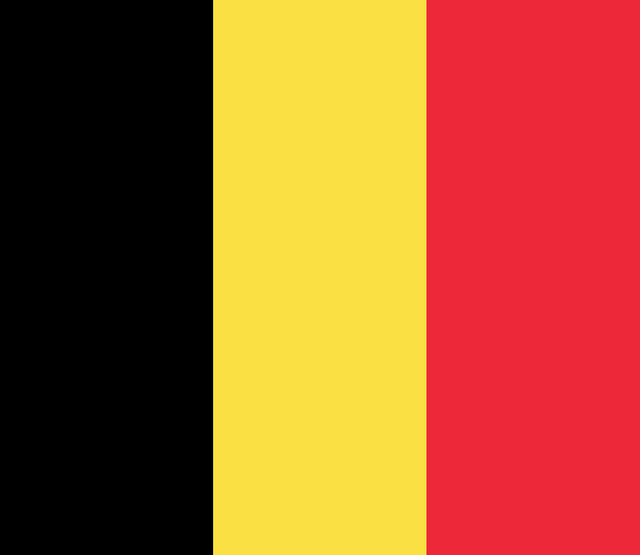
Belgium

Kingdom of Belgium | |
|---|---|
Anthem:"La Brabançonne" (English:"The Brabantian") | |
 Location of Belgium (dark green)– in Europe (green & dark grey) – in the European Union (green) | |
 | |
| Capital and largest city | Brussels 50°51′N 4°21′E [254] |
| Official languages | Dutch French German |
| Ethnic groups | see Demographics |
| Religion (2015[11]) |
|
| Demonym(s) | Belgian |
| Government | Federal parliamentary constitutional monarchy[12] |
• Monarch | Philippe |
• Prime Minister | Charles Michel |
| Legislature | Federal Parliament |
• Upper house | Senate |
• Lower house | Chamber of Representatives |
| Independence (from the Netherlands) | |
• Declared | 4 October 1830 |
• Recognised | 19 April 1839 |
| Area | |
• Total | 30,688 km2(11,849 sq mi) (136th) |
• Water (%) | 6.4 |
| Population | |
• 1 August 2018 census | 11,420,163 |
• Density | 374.2/km2(969.2/sq mi) (36th) |
| GDP(PPP) | 2018 estimate |
• Total | $550 billion[14] (38th) |
• Per capita | $48,224[14] (20th) |
| GDP(nominal) | 2018 estimate |
• Total | $533 billion[14] (23rd) |
• Per capita | $46,724[14] (17th) |
| Gini(2017) | low |
| HDI(2017) | very high · 17th |
| Currency | Euro (€) (EUR) |
| Time zone | UTC+1(CET) |
• Summer (DST) | UTC+2(CEST) |
| Driving side | right |
| Calling code | +32 |
| ISO 3166 code | BE |
| Internet TLD | .be |
| |
Belgium,[1] officially the Kingdom of Belgium, is a sovereign state in Western Europe. It is bordered by the Netherlands to the north, Germany to the east, Luxembourg to the southeast, France to the southwest, and the North Sea to the northwest. It covers an area of 30,688 km2 (11,849 sq mi) and has a population of more than 11.4 million. The capital and largest city is Brussels; other major cities are Antwerp, Ghent, Charleroi and Liège.
Belgium is a federal constitutional monarchy with a parliamentary system. Its institutional organization is complex and is structured on both regional and linguistic grounds. It is divided into three highly autonomous regions:[18] Flanders in the north, Wallonia in the south, and the Brussels-Capital Region. Brussels is the smallest and most densely populated region, as well as the richest region in terms of GDP per capita.
Belgium is home to two main linguistic groups or communities: the Dutch-speaking, mostly Flemish Community, which constitutes about 59 percent of the population, and the French-speaking Community, which comprises about 40 percent of all Belgians. A small German-speaking Community, numbering around one percent, exists in the East Cantons. The Brussels-Capital Region is officially bilingual (French and Dutch), although French is the dominant language.[19] Belgium's linguistic diversity and related political conflicts are reflected in its political history and complex system of governance, made up of six different governments.
Historically, Belgium was part of an area known as the Low Countries, a somewhat larger region than the current Benelux group of states that also included parts of northern France and western Germany. Its name is derived from the Latin word Belgica, after the Roman province of Gallia Belgica. From the end of the Middle Ages until the 17th century, the area of Belgium was a prosperous and cosmopolitan center of commerce and culture. Between the 16th and early 19th centuries, Belgium served as the battleground between many European powers, earning the moniker the "Battlefield of Europe",[20] a reputation strengthened by both world wars. The country emerged in 1830 following the Belgian Revolution when it seceded from the Netherlands.
Belgium participated in the Industrial Revolution[21][22] and, during the course of the 20th century, possessed a number of colonies in Africa.[23] The second half of the 20th century was marked by rising tensions between the Dutch-speaking and the French-speaking citizens fueled by differences in language and culture and the unequal economic development of Flanders and Wallonia. This continuing antagonism has led to several far-reaching reforms, resulting in a transition from a unitary to a federal arrangement during the period from 1970 to 1993. Despite the reforms, tensions between the groups have remained, if not increased; there is significant separatism particularly among the Flemish; controversial language laws exist such as the municipalities with language facilities;[24] and the formation of a coalition government took 18 months following the June 2010 federal election, a world record.[25] Unemployment in Wallonia is more than double that of Flanders, which boomed after the war.[26]
Belgium is one of the six founding countries of the European Union and its capital, Brussels, hosts the official seats of the European Commission, the Council of the European Union, and the European Council, as well as one of two seats of the European Parliament (the other being Strasbourg). Belgium is also a founding member of the Eurozone, NATO, OECD, and WTO, and a part of the trilateral Benelux Union and the Schengen Area. Brussels hosts several of the EU's official seats as well as the headquarters of many major international organizations such as NATO.[2]
Belgium is a developed country, with an advanced high-income economy. It has very high standards of living, quality of life,[27] healthcare,[28] education,[29] and is categorized as "very high" in the Human Development Index.[30] It also ranks as one of the safest or most peaceful countries in the world.[31]
Kingdom of Belgium | |
|---|---|
Anthem:"La Brabançonne" (English:"The Brabantian") | |
 Location of Belgium (dark green)– in Europe (green & dark grey) – in the European Union (green) | |
 | |
| Capital and largest city | Brussels 50°51′N 4°21′E [254] |
| Official languages | Dutch French German |
| Ethnic groups | see Demographics |
| Religion (2015[11]) |
|
| Demonym(s) | Belgian |
| Government | Federal parliamentary constitutional monarchy[12] |
• Monarch | Philippe |
• Prime Minister | Charles Michel |
| Legislature | Federal Parliament |
• Upper house | Senate |
• Lower house | Chamber of Representatives |
| Independence (from the Netherlands) | |
• Declared | 4 October 1830 |
• Recognised | 19 April 1839 |
| Area | |
• Total | 30,688 km2(11,849 sq mi) (136th) |
• Water (%) | 6.4 |
| Population | |
• 1 August 2018 census | 11,420,163 |
• Density | 374.2/km2(969.2/sq mi) (36th) |
| GDP(PPP) | 2018 estimate |
• Total | $550 billion[14] (38th) |
• Per capita | $48,224[14] (20th) |
| GDP(nominal) | 2018 estimate |
• Total | $533 billion[14] (23rd) |
• Per capita | $46,724[14] (17th) |
| Gini(2017) | low |
| HDI(2017) | very high · 17th |
| Currency | Euro (€) (EUR) |
| Time zone | UTC+1(CET) |
• Summer (DST) | UTC+2(CEST) |
| Driving side | right |
| Calling code | +32 |
| ISO 3166 code | BE |
| Internet TLD | .be |
| |
History
Pre-independent Belgium
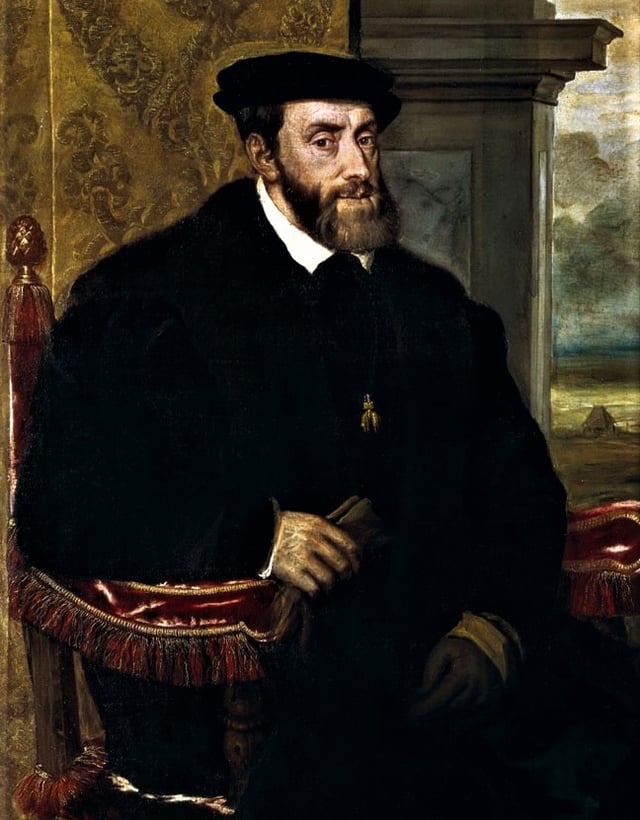
Charles V, Holy Roman Emperor, was born in Ghent
Gaul is divided into three parts, one of which the Belgae inhabit, the Aquitani another, those who in their own language are called Celts, in ours Gauls, the third. (...) Of all these, the Belgae are the strongest (...) . — Julius Caesar, De Bello Gallico, Book I, Ch. 1
The name "Belgium" is derived from Gallia Belgica, a Roman province in the northernmost part of Gaul that before Roman invasion in 100 BC, was inhabited by the Belgae, a mix of Celtic and Germanic peoples.[32][3] A gradual immigration by Germanic Frankish tribes during the 5th century brought the area under the rule of the Merovingian kings. A gradual shift of power during the 8th century led the kingdom of the Franks to evolve into the Carolingian Empire.[33]
The Treaty of Verdun in 843 divided the region into Middle and West Francia and therefore into a set of more or less independent fiefdoms which, during the Middle Ages, were vassals either of the King of France or of the Holy Roman Emperor.[33]
Many of these fiefdoms were united in the Burgundian Netherlands of the 14th and 15th centuries.[34] Emperor Charles V extended the personal union of the Seventeen Provinces in the 1540s, making it far more than a personal union by the Pragmatic Sanction of 1549 and increased his influence over the Prince-Bishopric of Liège.[35]
The Eighty Years' War (1568–1648) divided the Low Countries into the northern United Provinces (Belgica Foederata in Latin, the "Federated Netherlands") and the Southern Netherlands (Belgica Regia, the "Royal Netherlands"). The latter were ruled successively by the Spanish (Spanish Netherlands) and the Austrian Habsburgs (Austrian Netherlands) and comprised most of modern Belgium. This was the theatre of most Franco-Spanish and Franco-Austrian wars during the 17th and 18th centuries.
Following the campaigns of 1794 in the French Revolutionary Wars, the Low Countries—including territories that were never nominally under Habsburg rule, such as the Prince-Bishopric of Liège—were annexed by the French First Republic, ending Austrian rule in the region. The reunification of the Low Countries as the United Kingdom of the Netherlands occurred at the dissolution of the First French Empire in 1814, after the abdication of Napoleon.
Independent Belgium
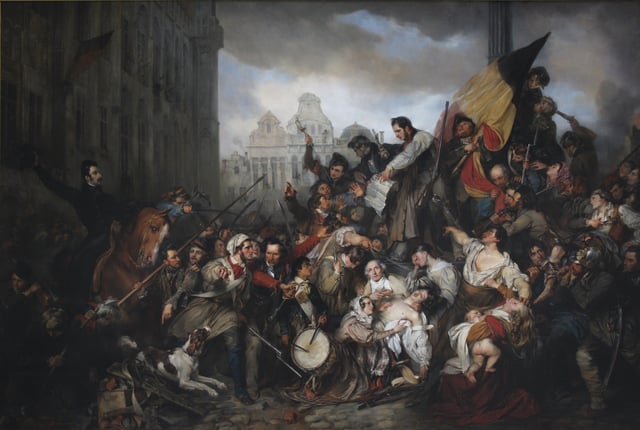
Episode of the Belgian Revolution of 1830 (1834), by Gustaf Wappers
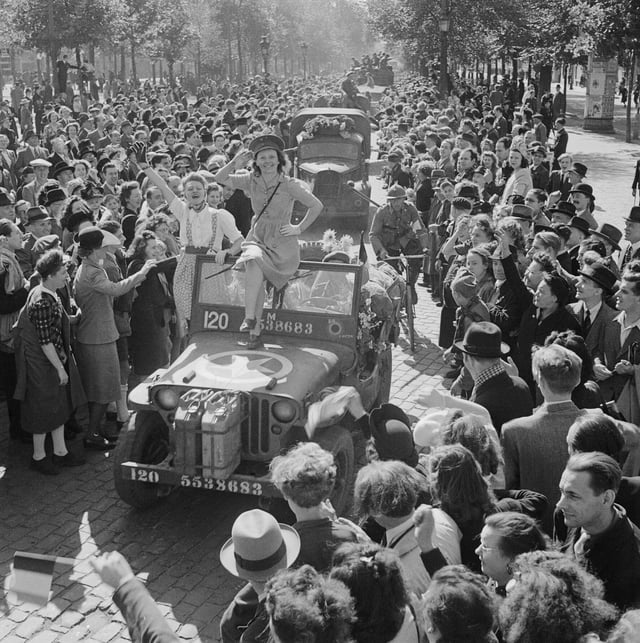
Cheering crowds greet British troops entering Brussels, 4 September 1944
In 1830, the Belgian Revolution led to the separation of the Southern Provinces from the Netherlands and to the establishment of a Catholic and bourgeois, officially French-speaking and neutral, independent Belgium under a provisional government and a national congress.[36][37] Since the installation of Leopold I as king on 21 July 1831, now celebrated as Belgium's National Day, Belgium has been a constitutional monarchy and parliamentary democracy, with a laicist constitution based on the Napoleonic code.[38] Although the franchise was initially restricted, universal suffrage for men was introduced after the general strike of 1893 (with plural voting until 1919) and for women in 1949.
The main political parties of the 19th century were the Catholic Party and the Liberal Party, with the Belgian Labour Party emerging towards the end of the 19th century. French was originally the single official language adopted by the nobility and the bourgeoisie. It progressively lost its overall importance as Dutch became recognized as well. This recognition became official in 1898 and in 1967 the parliament accepted a Dutch version of the Constitution.[39]
The Berlin Conference of 1885 ceded control of the Congo Free State to King Leopold II as his private possession. From around 1900 there was growing international concern for the extreme and savage treatment of the Congolese population under Leopold II, for whom the Congo was primarily a source of revenue from ivory and rubber production.[40] Many Congolese were killed by Leopold's agents for failing to meet production quotas for ivory and rubber.[41] It is estimated that nearly 10 million were killed during the Leopold period. In 1908, this outcry led the Belgian state to assume responsibility for the government of the colony, henceforth called the Belgian Congo.[42] A Belgian commission in 1919 estimated that Congo's population was half what it was in 1879.[41]
Germany invaded Belgium in August 1914 as part of the Schlieffen Plan to attack France, and much of the Western Front fighting of World War I occurred in western parts of the country. The opening months of the war were known as the Rape of Belgium due to German excesses. Belgium assumed control of the German colonies of Ruanda-Urundi (modern-day Rwanda and Burundi) during the war, and in 1924 the League of Nations mandated them to Belgium. In the aftermath of the First World War, Belgium annexed the Prussian districts of Eupen and Malmedy in 1925, thereby causing the presence of a German-speaking minority.
German forces again invaded the country in May 1940, and 40,690 Belgians, over half of them Jews, were killed during the subsequent occupation and The Holocaust. From September 1944 to February 1945 the Allies liberated Belgium. After World War II, a general strike forced King Leopold III to abdicate in 1951, since many Belgians felt he had collaborated with Germany during the war.[43] The Belgian Congo gained independence in 1960 during the Congo Crisis;[44] Ruanda-Urundi followed with its independence two years later. Belgium joined NATO as a founding member and formed the Benelux group of nations with the Netherlands and Luxembourg.
Belgium became one of the six founding members of the European Coal and Steel Community in 1951 and of the European Atomic Energy Community and European Economic Community, established in 1957. The latter has now become the European Union, for which Belgium hosts major administrations and institutions, including the European Commission, the Council of the European Union and the extraordinary and committee sessions of the European Parliament.
Geography
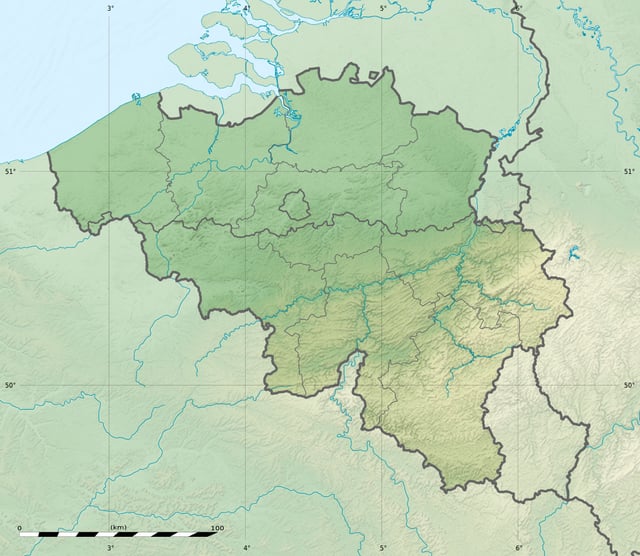
A relief map of Belgium
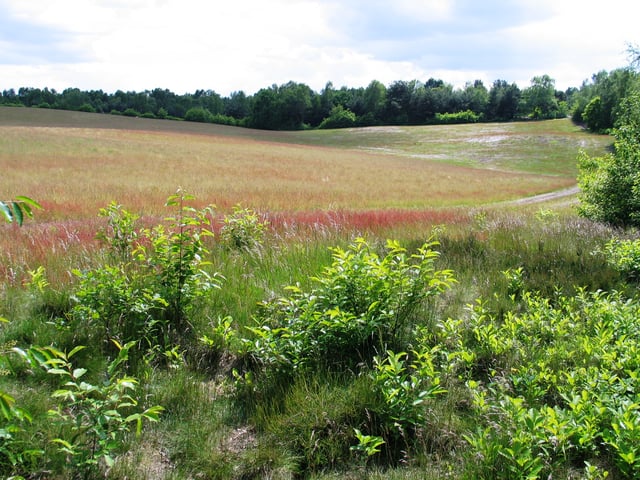
Campine landscape.

The Meuse river between Dinant and Hastière.
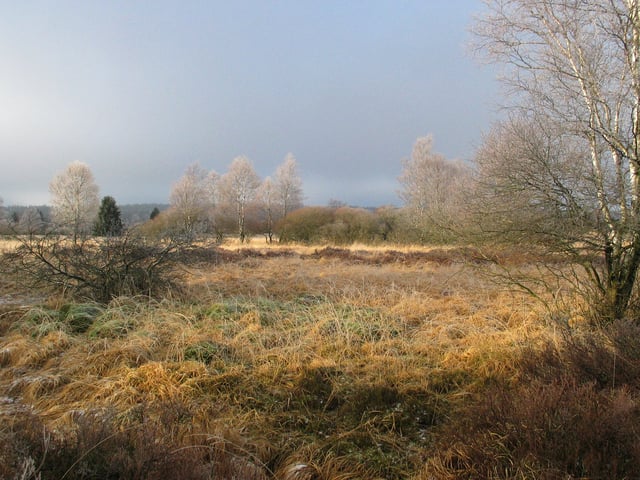
High Fens landscape near the German border.
Belgium shares borders with France (620 km), Germany (167 km), Luxembourg (148 km) and the Netherlands (450 km). Its total surface, including water area, is 30,688 km2 (11,849 sq mi). Before 2018, its total area was believed to be 30,528 km2 (11,787 sq mi). However, when the country's statistics were measured in 2018, a new calculation method was used. Unlike previous calculations, this one included the area from the coast to the low-water line, revealing the country to be 160 km2 (62 sq mi) larger in surface area than previously thought.[45][46] Its land area alone is 30,278 km2.[47] It lies between latitudes 49°30' and 51°30' N, and longitudes 2°33' and 6°24' E.[48]
Belgium has three main geographical regions; the coastal plain in the northwest and the central plateau both belong to the Anglo-Belgian Basin, and the Ardennes uplands in the southeast to the Hercynian orogenic belt. The Paris Basin reaches a small fourth area at Belgium's southernmost tip, Belgian Lorraine.[49]
The coastal plain consists mainly of sand dunes and polders. Further inland lies a smooth, slowly rising landscape irrigated by numerous waterways, with fertile valleys and the northeastern sandy plain of the Campine (Kempen). The thickly forested hills and plateaus of the Ardennes are more rugged and rocky with caves and small gorges. Extending westward into France, this area is eastwardly connected to the Eifel in Germany by the High Fens plateau, on which the Signal de Botrange forms the country's highest point at 694 m (2,277 ft).[50][51]
The climate is maritime temperate with significant precipitation in all seasons (Köppen climate classification: Cfb), like most of northwest Europe.[52] The average temperature is lowest in January at 3 °C (37.4 °F) and highest in July at 18 °C (64.4 °F). The average precipitation per month varies between 54 mm (2.1 in) for February and April, to 78 mm (3.1 in) for July.[53] Averages for the years 2000 to 2006 show daily temperature minimums of 7 °C (44.6 °F) and maximums of 14 °C (57.2 °F) and monthly rainfall of 74 mm (2.9 in); these are about 1 °C and nearly 10 millimetres above last century's normal values, respectively.[54]
Phytogeographically, Belgium is shared between the Atlantic European and Central European provinces of the Circumboreal Region within the Boreal Kingdom.[55] According to the World Wide Fund for Nature, the territory of Belgium belongs to the ecoregion of Atlantic mixed forests.[56] Because of its high population density, industrialization and its location in the center of Western Europe, Belgium still faces some environmental problems. However, due to consistent efforts by the various levels of government in Belgium, the state of the environment in Belgium is gradually improving. This led to Belgium being ranked as one of the top 10 countries (9 out of 132) in terms of environmental protection trends, and to Belgium being ranked in 2012 as the 24th country out of 132 for environmental protection. Belgium moreover has one of Europe's highest waste recycling rates. In particular, the Flemish region of Belgium has the highest waste diversion rate in Europe. Almost 75 percent of the residential waste produced there is reused, recycled, or composted.
Provinces
The territory of Belgium is divided into three Regions, two of which, the Flemish Region and Walloon Region, are in turn subdivided into provinces; the third Region, the Brussels Capital Region, is neither a province nor a part of a province.
| Province | Dutch name | French name | German name | Capital | Largest city | Area (km2) | Population (1 January 2018) |
|---|---|---|---|---|---|---|---|
| Antwerp | Antwerpen | Anvers | Antwerpen | Antwerp (Dutch: Antwerpen) (French: Anvers) | Antwerp (Dutch: Antwerpen) (French: Anvers) | 2,860 | 1,847,486 |
| East Flanders | Oost-Vlaanderen | Flandre-Orientale | Ostflandern | Ghent (Dutch: Gent) (French: Gand) | Ghent (Dutch: Gent) (French: Gand) | 2,982 | 1,505,053 |
| Flemish Brabant | Vlaams-Brabant | Brabant flamand | Flämisch Brabant | Leuven (French: Louvain) (German: Löwen) | Leuven (French: Louvain) | 2,106 | 1,138,489 |
| Hainaut | Henegouwen | Hainaut | Hennegau | Mons (Dutch: Bergen) | Charleroi | 3,800 | 1,341,645 |
| Liège | Luik | Liège | Lüttich | Liège (Dutch: Luik) (German: Lüttich) | Liège (Dutch: Luik) (German: Lüttich) | 3,844 | 1,105,326 |
| Limburg | Limburg | Limbourg | Limburg | Hasselt | Hasselt | 2,414 | 870,880 |
| Luxembourg | Luxemburg | Luxembourg | Luxemburg | Arlon (Dutch: Aarlen) (German: Arel) | Arlon (Dutch: Aarlen) (German: Arel) | 4,443 | 283,227 |
| Namur | Namen | Namur | Namur | Namur (Dutch: Namen) | Namur (Dutch: Namen) | 3,664 | 493,073 |
| Walloon Brabant | Waals-Brabant | Brabant wallon | Wallonisch Brabant | Wavre (Dutch: Waver) | Braine-l'Alleud (Dutch: Eigenbrakel) | 1,093 | 401,106 |
| West Flanders | West-Vlaanderen | Flandre-Occidentale | Westflandern | Bruges (Dutch: Brugge) (French: Bruges) (German: Brügge) | Bruges (Dutch: Brugge) (French: Bruges) (German: Brügge) | 3,151 | 1,191,059 |
Politics
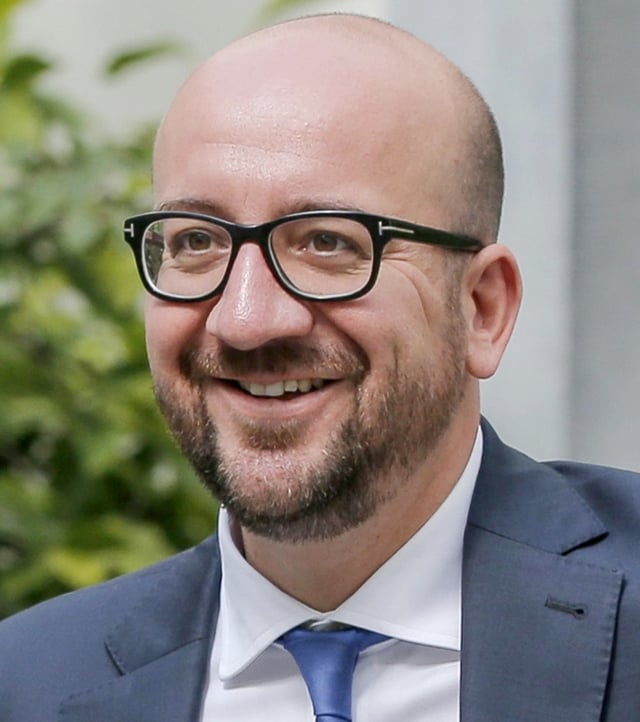
Charles MichelPrime Minister since 2014
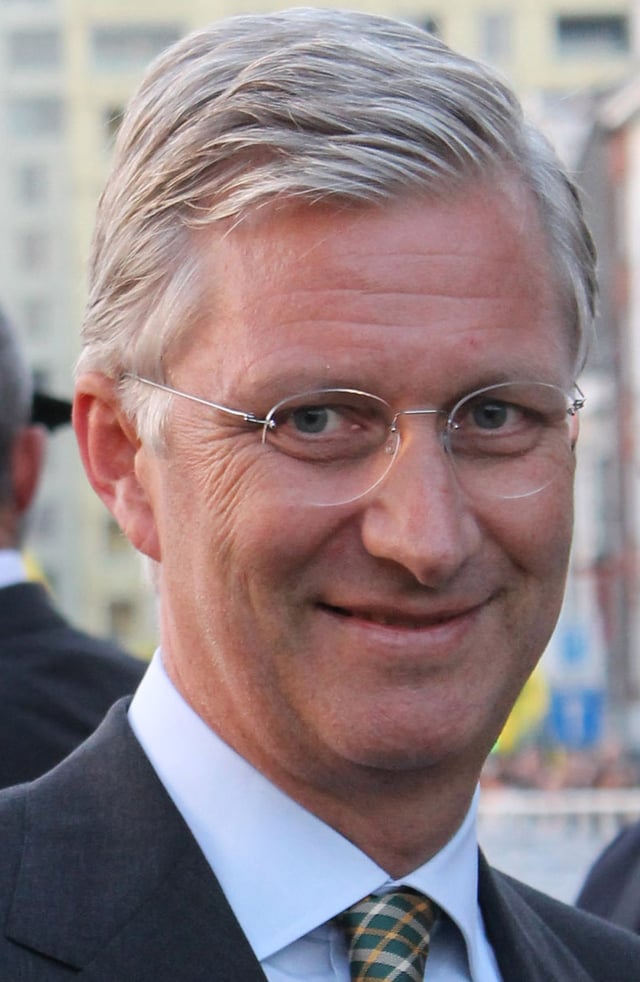
PhilippeKing of the Belgians since 2013
Belgium is a constitutional, popular monarchy and a federal parliamentary democracy. The bicameral federal parliament is composed of a Senate and a Chamber of Representatives. The former is made up of 50 senators appointed by the parliaments of the communities and regions and 10 co-opted senators. Prior to 2014, most of the Senate's members were directly elected. The Chamber's 150 representatives are elected under a proportional voting system from 11 electoral districts. Belgium has compulsory voting and thus maintains one of the highest rates of voter turnout in the world.[57]
The King (currently Philippe) is the head of state, though with limited prerogatives. He appoints ministers, including a Prime Minister, that have the confidence of the Chamber of Representatives to form the federal government. The Council of Ministers is composed of no more than fifteen members. With the possible exception of the Prime Minister, the Council of Ministers is composed of an equal number of Dutch-speaking members and French-speaking members.[58] The judicial system is based on civil law and originates from the Napoleonic code. The Court of Cassation is the court of last resort, with the courts of appeal one level below.[59]
Political culture
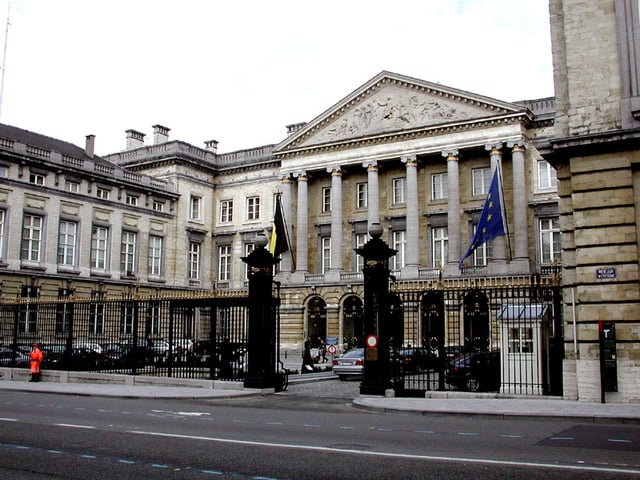
The Belgian Federal Parliament in Brussels, one of six different governments of the country
Belgium's political institutions are complex; most political power is organized around the need to represent the main cultural communities.[60] Since about 1970, the significant national Belgian political parties have split into distinct components that mainly represent the political and linguistic interests of these communities.[61] The major parties in each community, though close to the political center, belong to three main groups: Christian Democrats, Liberals, and Social Democrats.[62] Further notable parties came into being well after the middle of last century, mainly around linguistic, nationalist, or environmental themes and recently smaller ones of some specific liberal nature.[61]
A string of Christian Democrat coalition governments from 1958 was broken in 1999 after the first dioxin crisis, a major food contamination scandal.[63][64][65] A "rainbow coalition" emerged from six parties: the Flemish and the French-speaking Liberals, Social Democrats and Greens.[66] Later, a "purple coalition" of Liberals and Social Democrats formed after the Greens lost most of their seats in the 2003 election.[67]
The government led by Prime Minister Guy Verhofstadt from 1999 to 2007 achieved a balanced budget, some tax reforms, a labor-market reform, scheduled nuclear phase-out and instigated legislation allowing more stringent war crime and more lenient soft drug usage prosecution. Restrictions on withholding euthanasia were reduced and same-sex marriage legalized. The government promoted active diplomacy in Africa[68] and opposed the invasion of Iraq.[69] It is the only country that does not have age restrictions on euthanasia.[70]
Verhofstadt's coalition fared badly in the June 2007 elections. For more than a year, the country experienced a political crisis.[71] This crisis was such that many observers speculated on a possible partition of Belgium.[72][73][74] From 21 December 2007 until 20 March 2008 the temporary Verhofstadt III Government was in office. This coalition of the Flemish and Francophone Christian Democrats, the Flemish and Francophone Liberals together with the Francophone Social Democrats was an interim government until 20 March 2008.[75]
On that day a new government, led by Flemish Christian Democrat Yves Leterme, the actual winner of the federal elections of June 2007, was sworn in by the king. On 15 July 2008 Leterme announced the resignation of the cabinet to the king, as no progress in constitutional reforms had been made.[75] In December 2008 he once more offered his resignation to the king after a crisis surrounding the sale of Fortis to BNP Paribas.[76] At this juncture, his resignation was accepted and Christian Democratic and Flemish Herman Van Rompuy was sworn in as Prime Minister on 30 December 2008.[77]
After Herman Van Rompuy was designated the first permanent President of the European Council on 19 November 2009, he offered the resignation of his government to King Albert II on 25 November 2009. A few hours later, the new government under Prime Minister Yves Leterme was sworn in. On 22 April 2010, Leterme again offered the resignation of his cabinet to the king[78] after one of the coalition partners, the OpenVLD, withdrew from the government, and on 26 April 2010 King Albert officially accepted the resignation.[79]
The Parliamentary elections in Belgium on 13 June 2010 saw the Flemish nationalist N-VA become the largest party in Flanders, and the Socialist Party PS the largest party in Wallonia.[80] Until December 2011, Belgium was governed by Leterme's caretaker government awaiting the end of the deadlocked negotiations for formation of a new government. By 30 March 2011 this set a new world record for the elapsed time without an official government, previously held by war-torn Iraq.[81] Finally, in December 2011 the Di Rupo Government led by Walloon socialist Prime Minister Elio Di Rupo was sworn in.
The 2014 federal election (coinciding with the regional elections) resulted in a further electoral gain for the Flemish nationalist N-VA, although the incumbent coalition (composed of Flemish and French-speaking Social Democrats, Liberals, and Christian Democrats) maintains a solid majority in Parliament and in all electoral constituencies. On 22 July 2014, King Philippe nominated Charles Michel (MR) and Kris Peeters (CD&V) to lead the formation of a new federal cabinet composed of the Flemish parties N-VA, CD&V, Open Vld and the French-speaking MR, which resulted in the Michel Government. It is the first time N-VA is part of the federal cabinet, while the French-speaking side is represented only by the MR, which achieved a minority of the public votes in Wallonia.
Communities and regions

Communities: Flemish Community / Dutch language area Flemish & French Community / bilingual language area French Community / French language area German-speaking Community / German language area

Regions: Flemish Region / Dutch language area Brussels-Capital Region / bilingual area Walloon Region / French and German language areas
Following a usage which can be traced back to the Burgundian and Habsburg courts,[82] in the 19th century it was necessary to speak French to belong to the governing upper class, and those who could only speak Dutch were effectively second-class citizens.[83] Late that century, and continuing into the 20th century, Flemish movements evolved to counter this situation.[84]
While the people in Southern Belgium spoke French or dialects of French, and most Brusselers adopted French as their first language, the Flemings refused to do so and succeeded progressively in making Dutch an equal language in the education system.[84] Following World War II, Belgian politics became increasingly dominated by the autonomy of its two main linguistic communities.[85] Intercommunal tensions rose and the constitution was amended to minimize the potential for conflict.[85]
The federal government, based in Brussels.
The three language communities: the Flemish Community (Dutch-speaking); the French Community (French-speaking); the German-speaking Community.
The three regions: the Flemish Region, subdivided into five provinces; the Walloon Region, subdivided into five provinces; the Brussels-Capital Region.
The constitutional language areas determine the official languages in their municipalities, as well as the geographical limits of the empowered institutions for specific matters.[88] Although this would allow for seven parliaments and governments when the Communities and Regions were created in 1980, Flemish politicians decided to merge both.[89] Thus the Flemings just have one single institutional body of parliament and government is empowered for all except federal and specific municipal matters.[4]
The overlapping boundaries of the Regions and Communities have created two notable peculiarities: the territory of the Brussels-Capital Region (which came into existence nearly a decade after the other regions) is included in both the Flemish and French Communities, and the territory of the German-speaking Community lies wholly within the Walloon Region. Conflicts about jurisdiction between the bodies are resolved by the Constitutional Court of Belgium. The structure is intended as a compromise to allow different cultures to live together peacefully.[21]
Locus of policy jurisdiction
The Federal State's authority includes justice, defense, federal police, social security, nuclear energy, monetary policy and public debt, and other aspects of public finances. State-owned companies include the Belgian Post Group and Belgian Railways. The Federal Government is responsible for the obligations of Belgium and its federalized institutions towards the European Union and NATO. It controls substantial parts of public health, home affairs and foreign affairs.[90] The budget—without the debt—controlled by the federal government amounts to about 50% of the national fiscal income. The federal government employs around 12% of the civil servants.[91]
Communities exercise their authority only within linguistically determined geographical boundaries, originally oriented towards the individuals of a Community's language: culture (including audiovisual media), education and the use of the relevant language. Extensions to personal matters less directly connected with language comprise health policy (curative and preventive medicine) and assistance to individuals (protection of youth, social welfare, aid to families, immigrant assistance services, and so on.).[92]
Regions have authority in fields that can be broadly associated with their territory. These include economy, employment, agriculture, water policy, housing, public works, energy, transport, the environment, town and country planning, nature conservation, credit and foreign trade. They supervise the provinces, municipalities and intercommunal utility companies.[93]
In several fields, the different levels each have their own say on specifics. With education, for instance, the autonomy of the Communities neither includes decisions about the compulsory aspect nor allows for setting minimum requirements for awarding qualifications, which remain federal matters.[90] Each level of government can be involved in scientific research and international relations associated with its powers. The treaty-making power of the Regions' and Communities' Governments is the broadest of all the Federating units of all the Federations all over the world.[94][95][96]
Foreign relations
Because of its location at the crossroads of Western Europe, Belgium has historically been the route of invading armies from its larger neighbors. With virtually defenseless borders, Belgium has traditionally sought to avoid domination by the more powerful nations which surround it through a policy of mediation. The Belgians have been strong advocates of European integration. Both the European Union and NATO are headquartered in Belgium.
Armed forces
The Belgian Armed Forces have about 47,000 active troops. In 2010, Belgium's defense budget totaled €3.95 billion (representing 1.12% of its GDP).[97] They are organized into one unified structure which consists of four main components: Land Component, or the Army; Air Component, or the Air Force; Naval Component, or the Navy; Medical Component. The operational commands of the four components are subordinate to the Staff Department for Operations and Training of the Ministry of Defense, which is headed by the Assistant Chief of Staff Operations and Training, and to the Chief of Defense.[98]
The effects of the Second World War made collective security a priority for Belgian foreign policy. In March 1948 Belgium signed the Treaty of Brussels and then joined NATO in 1948. However, the integration of the armed forces into NATO did not begin until after the Korean War.[99] The Belgians, along with the Luxembourg government, sent a detachment of battalion strength to fight in Korea known as the Belgian United Nations Command. This mission was the first in a long line of UN missions which the Belgians supported. Currently, the Belgian Naval Component is working closely together with the Dutch Navy under the command of the Admiral Benelux.
Economy

Belgium is part of a monetary union, the eurozone (dark blue), and of the EU single market

Steelmaking along the Meuse River at Ougrée, near Liège

Port of Zeebrugge
Belgium's strongly globalized economy[100] and its transport infrastructure are integrated with the rest of Europe. Its location at the heart of a highly industrialized region helped make it the world's 15th largest trading nation in 2007.[101][102] The economy is characterized by a highly productive work force, high GNP and high exports per capita.[103] Belgium's main imports are raw materials, machinery and equipment, chemicals, raw diamonds, pharmaceuticals, foodstuffs, transportation equipment, and oil products. Its main exports are machinery and equipment, chemicals, finished diamonds, metals and metal products, and foodstuffs.[47]
The Belgian economy is heavily service-oriented and shows a dual nature: a dynamic Flemish economy and a Walloon economy that lags behind.[21][104][5] One of the founding members of the European Union, Belgium strongly supports an open economy and the extension of the powers of EU institutions to integrate member economies. Since 1922, through the Belgium-Luxembourg Economic Union, Belgium and Luxembourg have been a single trade market with customs and currency union.[105]
Belgium was the first continental European country to undergo the Industrial Revolution, in the early 19th century.[106] Liège and Charleroi rapidly developed mining and steelmaking, which flourished until the mid-20th century in the Sambre and Meuse valley and made Belgium among one of the three most industrialized nations in the world from 1830 to 1910.[107][108] However, by the 1840s the textile industry of Flanders was in severe crisis, and the region experienced famine from 1846 to 1850.[109][110]
After World War II, Ghent and Antwerp experienced a rapid expansion of the chemical and petroleum industries. The 1973 and 1979 oil crises sent the economy into a recession; it was particularly prolonged in Wallonia, where the steel industry had become less competitive and experienced a serious decline.[111] In the 1980s and 1990s, the economic center of the country continued to shift northwards and is now concentrated in the populous Flemish Diamond area.[112]
By the end of the 1980s, Belgian macroeconomic policies had resulted in a cumulative government debt of about 120% of GDP. As of 2006, the budget was balanced and public debt was equal to 90.30% of GDP.[113] In 2005 and 2006, real GDP growth rates of 1.5% and 3.0%, respectively, were slightly above the average for the Euro area. Unemployment rates of 8.4% in 2005 and 8.2% in 2006 were close to the area average. By October 2010, this had grown to 8.5% compared to an average rate of 9.6% for the European Union as a whole (EU 27).[114][115] From 1832 until 2002, Belgium's currency was the Belgian franc. Belgium switched to the euro in 2002, with the first sets of euro coins being minted in 1999. The standard Belgian euro coins designated for circulation show the portrait of the monarch (first King Albert II, since 2013 King Philippe).
Despite an 18% decrease observed from 1970 to 1999, Belgium still had in 1999 the highest rail network density within the European Union with 113.8 km/1 000 km2. On the other hand, the same period, 1970–1999, has seen a huge growth (+56%) of the motorway network. In 1999, the density of km motorways per 1000 km2 and 1000 inhabitants amounted to 55.1 and 16.5 respectively and were significantly superior to the EU's means of 13.7 and 15.9.[116]
Belgium experiences some of the most congested traffic in Europe. In 2010, commuters to the cities of Brussels and Antwerp spent respectively 65 and 64 hours a year in traffic jams.[117] Like in most small European countries, more than 80% of the airways traffic is handled by a single airport, the Brussels Airport. The ports of Antwerp and Zeebrugge (Bruges) share more than 80% of Belgian maritime traffic, Antwerp being the second European harbor with a gross weight of goods handled of 115 988 000 t in 2000 after a growth of 10.9% over the preceding five years.[116][118] In 2016, the port of Antwerp handled 214 million tons after a year-on-year growth of 2.7%.[119]
There is a large economic gap between Flanders and Wallonia. Wallonia was historically wealthy compared to Flanders, mostly due to its heavy industries, but the decline of the steel industry post-World War II led to the region's rapid decline, whereas Flanders rose swiftly. Since then, Flanders has been prosperous, among the wealthiest regions in Europe, whereas Wallonia has been languishing. As of 2007, the unemployment rate of Wallonia is over double that of Flanders. The divide has played a key part in the tensions between the Flemish and Walloons in addition to the already-existing language divide. Pro-independence movements have gained high popularity in Flanders as a consequence. The separatist New Flemish Alliance (N-VA) party, for instance, is the largest party in Belgium.[120][121][122]
Science and technology

Gerardus Mercator
Contributions to the development of science and technology have appeared throughout the country's history. The 16th century Early Modern flourishing of Western Europe included cartographer Gerardus Mercator, anatomist Andreas Vesalius, herbalist Rembert Dodoens[123][124][125][126] and mathematician Simon Stevin among the most influential scientists.[127]
Chemist Ernest Solvay[128] and engineer Zenobe Gramme (École industrielle de Liège)[129] gave their names to the Solvay process and the Gramme dynamo, respectively, in the 1860s. Bakelite was developed in 1907–1909 by Leo Baekeland. Ernest Solvay also acted as a major philanthropist and gave its name to the Solvay Institute of Sociology, the Solvay Brussels School of Economics and Management and the International Solvay Institutes for Physics and Chemistry which are now part of the Université libre de Bruxelles. In 1911, he started a series of conferences, the Solvay Conferences on Physics and Chemistry, which have had a deep impact on the evolution of quantum physics and chemistry.[130] A major contribution to fundamental science was also due to a Belgian, Monsignor Georges Lemaître (Catholic University of Louvain), who is credited with proposing the Big Bang theory of the origin of the universe in 1927.[131]
Three Nobel Prizes in Physiology or Medicine were awarded to Belgians: Jules Bordet (Université libre de Bruxelles) in 1919, Corneille Heymans (University of Ghent) in 1938 and Albert Claude (Université libre de Bruxelles) together with Christian de Duve (Université catholique de Louvain) in 1974. François Englert (Université libre de Bruxelles) was awarded the Nobel Prize in Physics in 2013. Ilya Prigogine (Université libre de Bruxelles) was awarded the Nobel Prize in Chemistry in 1977.[132] Two Belgian mathematicians have been awarded the Fields Medal: Pierre Deligne in 1978 and Jean Bourgain in 1994.[133][134]
Demographics
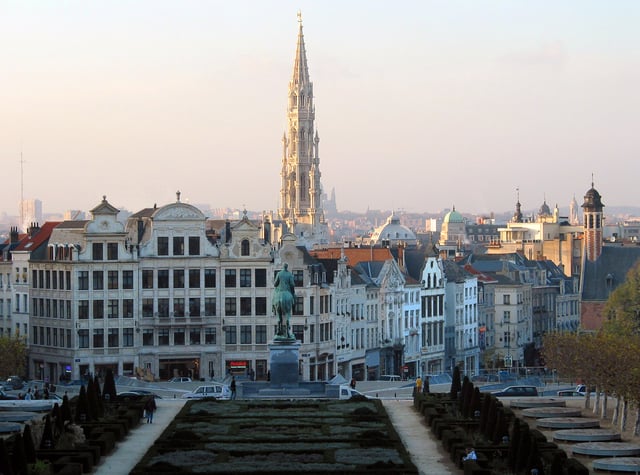
Brussels, the capital city and largest metropolitan area of Belgium
As of 1 January 2018, the total population of Belgium according to its population register was 11,376,070.[13] Almost all of the population is urban, at 97% in 2004.[135] The population density of Belgium is 373 per square kilometre (966 per square mile) as of January 2018. The most densely inhabited area is Flanders.[136] The Ardennes have the lowest density. As of 1 January 2018, the Flemish Region had a population of 6,552,967, its most populous cities being Antwerp (523,248), Ghent (260,341) and Bruges (118,284). Wallonia had 3,624,377 with Charleroi (201,816), Liège (197,355) and Namur (110,939), its most populous cities. Brussels has 1,198,726 inhabitants in the Capital Region's 19 municipalities, three of which have over 100,000 residents.[13]
In 2017 the average total fertility rate (TFR) across Belgium was 1.64 children per woman, below the replacement rate of 2.1, it remains considerably below the high of 4.87 children born per woman in 1873.[137] Belgium subsequently has one of the oldest populations in the world, with the average age of 41.5 years.[138]
Migration
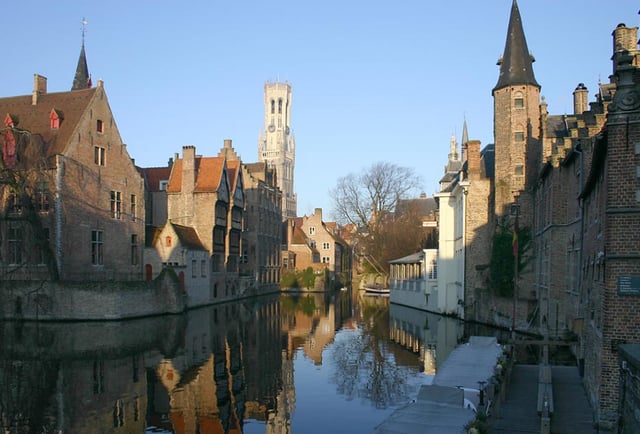
Bruges, historical city center, UNESCO World Heritage Site
As of 2007, nearly 92% of the population had Belgian citizenship,[139] and other European Union member citizens account for around 6%. The prevalent foreign nationals were Italian (171,918), French (125,061), Dutch (116,970), Moroccan (80,579), Portuguese (43,509), Spanish (42,765), Turkish (39,419) and German (37,621).[140][141] In 2007, there were 1.38 million foreign-born residents in Belgium, corresponding to 12.9% of the total population. Of these, 685,000 (6.4%) were born outside the EU and 695,000 (6.5%) were born in another EU Member State.[142][143]
At the beginning of 2012, people of foreign background and their descendants were estimated to have formed around 25% of the total population i.e. 2.8 million new Belgians.[144] Of these new Belgians, 1,200,000 are of European ancestry and 1,350,000[145] are from non-Western countries (most of them from Morocco, Turkey, and the DR Congo). Since the modification of the Belgian nationality law in 1984 more than 1.3 million migrants have acquired Belgian citizenship. The largest group of immigrants and their descendants in Belgium are Moroccans.[146] 89.2% of inhabitants of Turkish origin have been naturalized, as have 88.4% of people of Moroccan background, 75.4% of Italians, 56.2% of the French and 47.8% of Dutch people.[145]
Functional urban areas[147]
| Functional urban areas | Population 2011 |
|---|---|
| Brussels | 2,608,000 |
| Antwerp | 1,091,000 |
| Liège | 744,000 |
| Ghent | 591,000 |
| Charleroi | 488,000 |
Languages
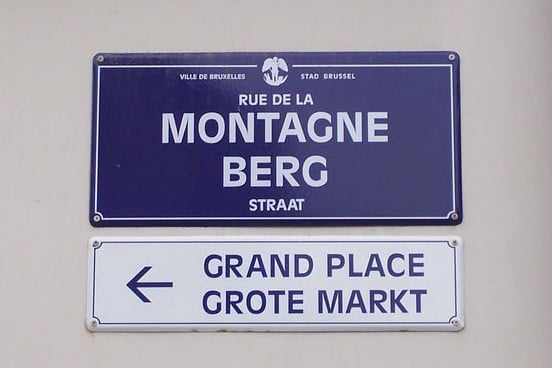
Bilingual signs in Brussels
Belgium has three official languages: Dutch, French and German. A number of non-official minority languages are spoken as well.[148] As no census exists, there are no official statistical data regarding the distribution or usage of Belgium's three official languages or their dialects.[149] However, various criteria, including the language(s) of parents, of education, or the second-language status of foreign born, may provide suggested figures. An estimated 60% of the Belgian population are native speakers of Dutch (often referred to as Flemish), and 40% of the population speaks French natively. French-speaking Belgians are often referred to as Walloons, although the French speakers in Brussels are not Walloons.[6]
The total number of native Dutch speakers is estimated to be about 6.23 million, concentrated in the northern Flanders region, while native French speakers number 3.32 million in Wallonia and an estimated 870,000 (or 85%) in the officially bilingual Brussels-Capital Region.[7][150] The German-speaking Community is made up of 73,000 people in the east of the Walloon Region; around 10,000 German and 60,000 Belgian nationals are speakers of German. Roughly 23,000 more German speakers live in municipalities near the official Community.[151][152][153][154]
Both Belgian Dutch and Belgian French have minor differences in vocabulary and semantic nuances from the varieties spoken respectively in the Netherlands and France. Many Flemish people still speak dialects of Dutch in their local environment. Walloon, considered either as a dialect of French or a distinct Romance language,[155][156] is now only understood and spoken occasionally, mostly by elderly people. Walloon is divided into four dialects, which along with those of Picard,[157] are rarely used in public life and have largely been replaced by French.
Religion

National Basilica of the Sacred Heart in Koekelberg, Brussels

Interior of the Great Synagogue of Brussels
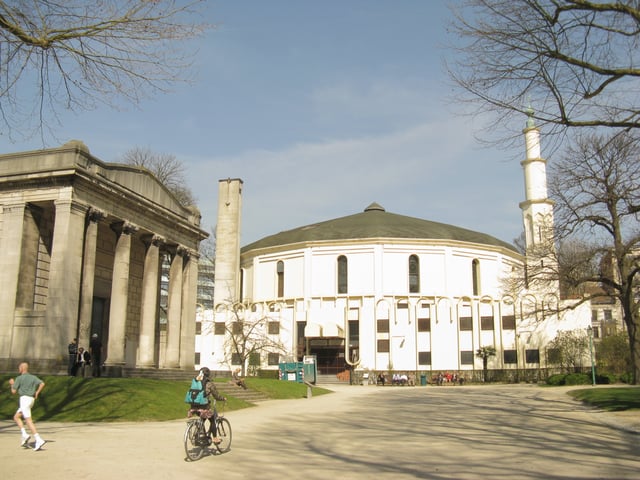
The Great Mosque of Brussels is the seat of the Islamic and Cultural Center of Belgium
Since the country's independence, Roman Catholicism, counterbalanced by strong freethought movements, has had an important role in Belgium's politics.[158] However Belgium is largely a secular country as the laicist constitution provides for freedom of religion, and the government generally respects this right in practice. During the reigns of Albert I and Baudouin, the Belgian royal family had a reputation of deeply rooted Catholicism.[159]
Roman Catholicism has traditionally been Belgium's majority religion; being especially strong in Flanders. However, by 2009 Sunday church attendance was 5% for Belgium in total; 3% in Brussels,[160] and 5.4% in Flanders. Church attendance in 2009 in Belgium was roughly half of the Sunday church attendance in 1998 (11% for the total of Belgium in 1998).[161] Despite the drop in church attendance, Catholic identity nevertheless remains an important part of Belgium's culture.[159]
According to the Eurobarometer 2010,[162] 37% of Belgian citizens responded that they believe there is a God. 31% answered that they believe there is some sort of spirit or life-force. 27% answered that they do not believe there is any sort of spirit, God, or life-force. 5% did not respond. According to the Eurobarometer 2015, 60.7% of the total population of Belgium adhered to Christianity, with Roman Catholicism being the largest denomination with 52.9%. Protestants comprised 2.1% and Orthodox Christians were the 1.6% of the total. Non-religious people comprised the 32.0% of the population and were divided between atheists (14.9%) and agnostics (17.1%). A further 5.2% of the population was Muslim and 2.1% were believers in other religions.[11] The same survey held in 2012 found that Christianity was the largest religion in Belgium accounting 65% of Belgians.[163]
In the early 2000s, there were approximately 42,000 Jews in Belgium. The Jewish Community of Antwerp (numbering some 18,000) is one of the largest in Europe, and one of the last places in the world where Yiddish is the primary language of a large Jewish community (mirroring certain Orthodox and Hasidic communities in New York, New Jersey, and Israel). In addition, most Jewish children in Antwerp receive a Jewish education.[165] There are several Jewish newspapers and more than 45 active synagogues (30 of which are in Antwerp) in the country. A 2006 inquiry in Flanders, considered to be a more religious region than Wallonia, showed that 55% considered themselves religious and that 36% believed that God created the universe.[166] On the other hand, Wallonia has become one of Europe's most secular/least religious regions. Most of the French-speaking region's population does not consider religion an important part of their lives, and as much as 45% of the population identifies as irreligious. This is particularly the case in eastern Wallonia and areas along the French border.
A 2008 estimate found that approximately 6% of the Belgian population (628,751 people) is Muslim.[167] Muslims constitute 23.6% of the population of Brussels, 4.9% of Wallonia and 5.1% of Flanders. The majority of Belgian Muslims live in the major cities, such as Antwerp, Brussels and Charleroi. The largest group of immigrants in Belgium are Moroccans, with 400,000 people. The Turks are the third largest group, and the second largest Muslim ethnic group, numbering 220,000.[146][168]
Health

University Hospital of Antwerp
The Belgians enjoy good health. According to 2012 estimates, the average life expectancy is 79.65 years.[47] Since 1960, life expectancy has, in line with the European average, grown by two months per year. Death in Belgium is mainly due to heart and vascular disorders, neoplasms, disorders of the respiratory system and unnatural causes of death (accidents, suicide). Non-natural causes of death and cancer are the most common causes of death for females up to age 24 and males up to age 44.[169]
Healthcare in Belgium is financed through both social security contributions and taxation. Health insurance is compulsory. Health care is delivered by a mixed public and private system of independent medical practitioners and public, university and semi-private hospitals. Health care service are payable by the patient and reimbursed later by health insurance institutions, but for ineligible categories (of patients and services) so-called 3rd party payment systems exist.[169] The Belgian health care system is supervised and financed by the federal government, the Flemish and Walloon Regional governments; and the German Community also has (indirect) oversight and responsibilities.[169]
For the first time in Belgian history, the first child was euthanized following the 2 year mark of the removal of the euthanization age restrictions. The child had been euthanized due to an incurable disease that was inflicted upon the child. Although there may have been some support for the euthanization there is a possibility of controversy due to the issue revolving around the subject of assisted suicide.[170][171]
Education
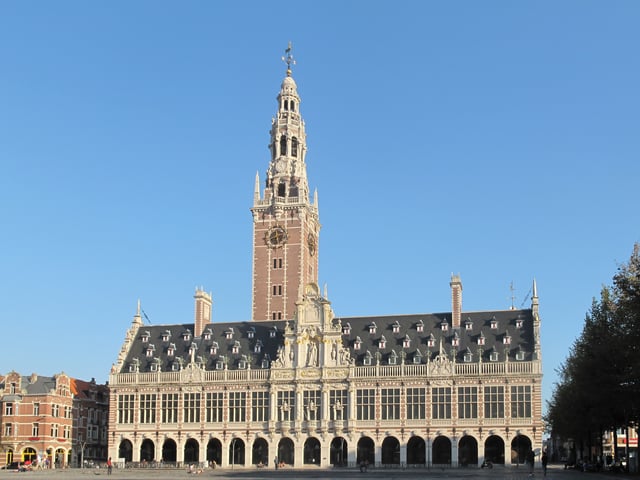
The Central Library of the KU Leuven University
Education is compulsory from 6 to 18 years of age for Belgians.[172] Among OECD countries in 2002, Belgium had the third highest proportion of 18- to 21-year-olds enrolled in postsecondary education, at 42%.[173] Though an estimated 99% of the adult population is literate, concern is rising over functional illiteracy.[157][174] The Programme for International Student Assessment (PISA), coordinated by the OECD, currently ranks Belgium's education as the 19th best in the world, being significantly higher than the OECD average.[175] Education being organized separately by each, the Flemish Community scores noticeably above the French and German-speaking Communities.[176]
Mirroring the dual structure of the 19th-century Belgian political landscape, characterized by the Liberal and the Catholic parties, the educational system is segregated within a secular and a religious segment. The secular branch of schooling is controlled by the communities, the provinces, or the municipalities, while religious, mainly Catholic branch education, is organized by religious authorities, although subsidized and supervised by the communities.[177]
Culture
Despite its political and linguistic divisions, the region corresponding to today's Belgium has seen the flourishing of major artistic movements that have had tremendous influence on European art and culture. Nowadays, to a certain extent, cultural life is concentrated within each language Community, and a variety of barriers have made a shared cultural sphere less pronounced.[21][178][179] Since the 1970s, there are no bilingual universities or colleges in the country except the Royal Military Academy and the Antwerp Maritime Academy, no common media[180] and no single large cultural or scientific organization in which both main communities are represented.[181]
Fine arts
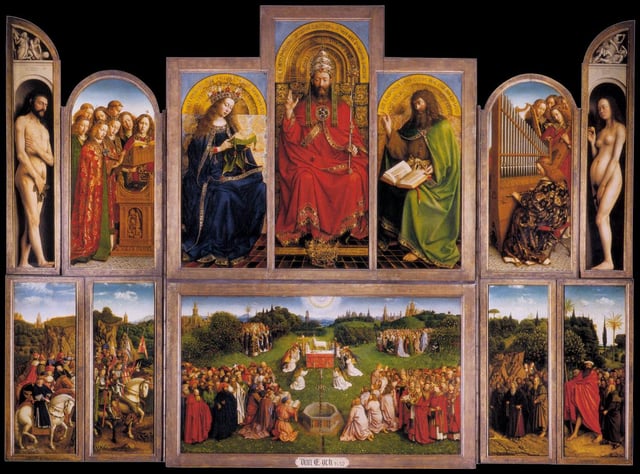
The Ghent Altarpiece: The Adoration of the Mystic Lamb (interior view), painted 1432 by van Eyck
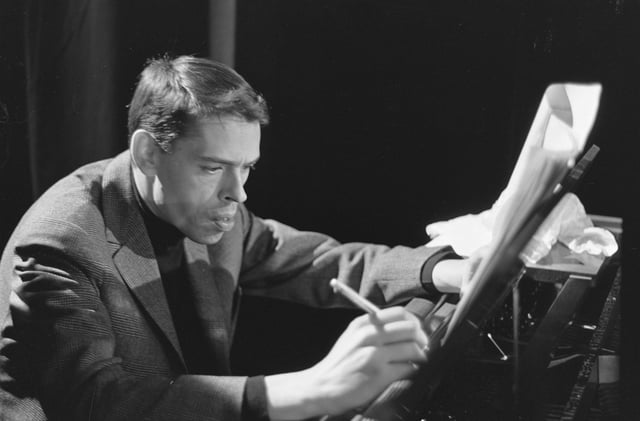
Jacques Brel, 1963
Contributions to painting and architecture have been especially rich. The Mosan art, the Early Netherlandish,[182] the Flemish Renaissance and Baroque painting[183] and major examples of Romanesque, Gothic, Renaissance and Baroque architecture[184] are milestones in the history of art. While the 15th century's art in the Low Countries is dominated by the religious paintings of Jan van Eyck and Rogier van der Weyden, the 16th century is characterized by a broader panel of styles such as Peter Breughel's landscape paintings and Lambert Lombard's representation of the antique.[185] Though the Baroque style of Peter Paul Rubens and Anthony van Dyck flourished in the early 17th century in the Southern Netherlands,[186] it gradually declined thereafter.[187][188]
During the 19th and 20th centuries many original romantic, expressionist and surrealist Belgian painters emerged, including James Ensor and other artists belonging to the Les XX group, Constant Permeke, Paul Delvaux and René Magritte. The avant-garde CoBrA movement appeared in the 1950s, while the sculptor Panamarenko remains a remarkable figure in contemporary art.[189][190] Multidisciplinary artists Jan Fabre, Wim Delvoye and the painter Luc Tuymans are other internationally renowned figures on the contemporary art scene.
Belgian contributions to architecture also continued into the 19th and 20th centuries, including the work of Victor Horta and Henry van de Velde, who were major initiators of the Art Nouveau style.[191][192]
The vocal music of the Franco-Flemish School developed in the southern part of the Low Countries and was an important contribution to Renaissance culture.[193] In the 19th and 20th centuries, there was an emergence of major violinists, such as Henri Vieuxtemps, Eugène Ysaÿe and Arthur Grumiaux, while Adolphe Sax invented the saxophone in 1846. The composer César Franck was born in Liège in 1822. Contemporary popular music in Belgium is also of repute. Jazz musician Toots Thielemans and singer Jacques Brel have achieved global fame. Nowadays, singer Stromae has been a musical revelation in Europe and beyond, having great success. In rock/pop music, Telex, Front 242, K's Choice, Hooverphonic, Zap Mama, Soulwax and dEUS are well known. In the heavy metal scene, bands like Machiavel, Channel Zero and Enthroned have a worldwide fan-base.[194]
Belgium has produced several well-known authors, including the poets Emile Verhaeren, Robert Goffin and novelists Hendrik Conscience, Georges Simenon, Suzanne Lilar, Hugo Claus and Amélie Nothomb. The poet and playwright Maurice Maeterlinck won the Nobel Prize in literature in 1911. The Adventures of Tintin by Hergé is the best known of Franco-Belgian comics, but many other major authors, including Peyo (The Smurfs), André Franquin (Gaston Lagaffe), Dupa (Cubitus), Morris (Lucky Luke), Greg (Achille Talon), Lambil (Les Tuniques Bleues), Edgar P. Jacobs and Willy Vandersteen brought the Belgian cartoon strip industry a worldwide fame.[195] Additionally, famous crime author Agatha Christie created the character Hercule Poirot, a Belgian detective, who has served as a protagonist in a number of her acclaimed mystery novels.
Belgian cinema has brought a number of mainly Flemish novels to life on-screen.[8] Other Belgian directors include André Delvaux, Stijn Coninx, Luc and Jean-Pierre Dardenne; well-known actors include Jean-Claude Van Damme, Jan Decleir and Marie Gillain; and successful films include Bullhead, Man Bites Dog and The Alzheimer Affair.[196] In the 1980s, Antwerp's Royal Academy of Fine Arts produced important fashion trendsetters, known as the Antwerp Six.[197]
Folklore
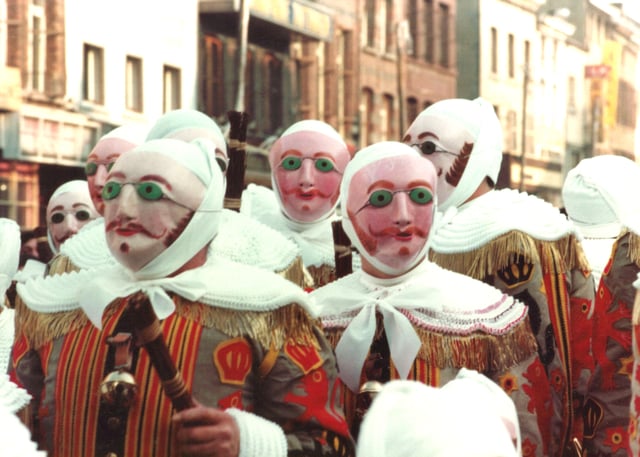
The Gilles of Binche, in costume, wearing wax masks
Folklore plays a major role in Belgium's cultural life: the country has a comparatively high number of processions, cavalcades, parades, 'ommegangs' and 'ducasses',[9] 'kermesse' and other local festivals, nearly always with an originally religious or mythological background. The Carnival of Binche with its famous Gilles and the 'Processional Giants and Dragons' of Ath, Brussels, Dendermonde, Mechelen and Mons are recognized by UNESCO as Masterpieces of the Oral and Intangible Heritage of Humanity.[198]
Other examples are the Carnival of Aalst; the still very religious processions of the Holy Blood in Bruges, Virga Jesse Basilica in Hasselt and Basilica of Our Lady of Hanswijk in Mechelen; 15 August festival in Liège; and the Walloon festival in Namur. Originated in 1832 and revived in the 1960s, the Gentse Feesten have become a modern tradition. A major non-official holiday is the Saint Nicholas Day, a festivity for children and, in Liège, for students.[199]
Cuisine
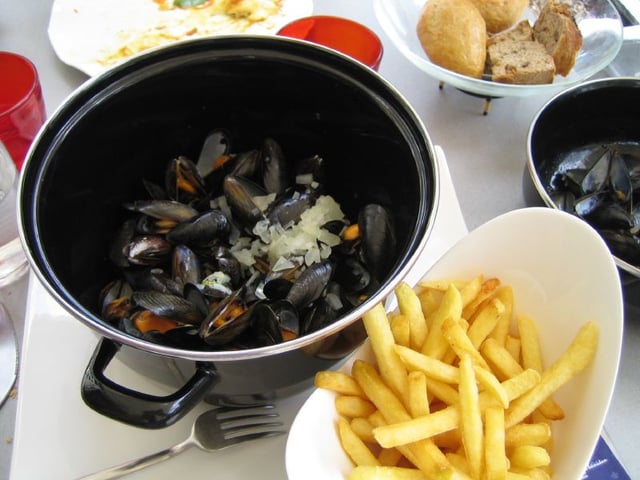
Moules-frites / mosselen met friet is a representative dish of Belgium
Many highly ranked Belgian restaurants can be found in the most influential restaurant guides, such as the Michelin Guide.[200] Belgium is famous for beer, chocolate, waffles and french fries with mayonnaise. Contrary to their name, french fries are claimed to have originated in Belgium, although their exact place of origin is uncertain. The national dishes are "steak and fries with salad", and "mussels with fries".[201][202][203][10]
Brands of Belgian chocolate and pralines, like Côte d'Or, Neuhaus, Leonidas and Godiva are famous, as well as independent producers such as Burie and Del Rey in Antwerp and Mary's in Brussels.[204] Belgium produces over 1100 varieties of beer.[205][206] The Trappist beer of the Abbey of Westvleteren has repeatedly been rated the world's best beer.[207][208][209] The biggest brewer in the world by volume is Anheuser-Busch InBev, based in Leuven.[210]
Sports

Eddy Merckx, regarded as one of the greatest cyclists of all time
Since the 1970s, sports clubs and federations are organized separately within each language community.[211] Association football is the most popular sport in both parts of Belgium; also very popular are cycling, tennis, swimming, judo[212] and basketball.[213]
Belgians hold the most Tour de France victories of any country except France. They have also the most victories on the UCI Road World Championships. Philippe Gilbert is the 2012 world champion. Another modern well-known Belgian cyclist is Tom Boonen. With five victories in the Tour de France and numerous other cycling records, Belgian cyclist Eddy Merckx is regarded as one of the greatest cyclists of all time.[214] Jean-Marie Pfaff, a former Belgian goalkeeper, is considered one of the greatest in the history of association football.[215]
Belgium hosted the 1972 European Football Championships, and co-hosted the 2000 European Championships with the Netherlands. The Belgium national football team reached first place in the FIFA World Rankings for the first time in November 2015.[216]
Kim Clijsters and Justine Henin both were Player of the Year in the Women's Tennis Association as they were ranked the number one female tennis player.
The Spa-Francorchamps motor-racing circuit hosts the Formula One World Championship Belgian Grand Prix. The Belgian driver, Jacky Ickx, won eight Grands Prix and six 24 Hours of Le Mans and finished twice as runner-up in the Formula One World Championship. Belgium also has a strong reputation in, motocross with the rider Stefan Everts.[217] Sporting events annually held in Belgium include the Memorial Van Damme athletics competition, the Belgian Grand Prix Formula One, and a number of classic cycle races such as the Tour of Flanders and Liège–Bastogne–Liège. The 1920 Summer Olympics were held in Antwerp. The 1977 European Basketball Championship was held in Liège and Ostend.
See also
Index of Belgium-related articles
Outline of Belgium

